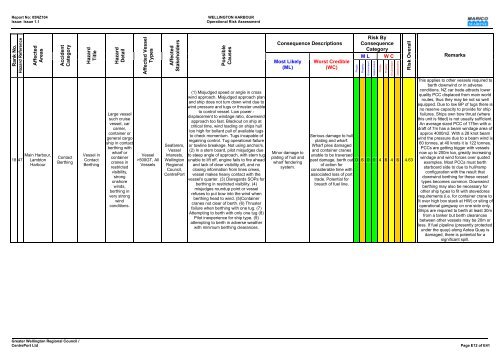MARICO Marine NZ Limited WELLINGTON HARBOUR PORT AND ...
MARICO Marine NZ Limited WELLINGTON HARBOUR PORT AND ...
MARICO Marine NZ Limited WELLINGTON HARBOUR PORT AND ...
Create successful ePaper yourself
Turn your PDF publications into a flip-book with our unique Google optimized e-Paper software.
Report No: 05<strong>NZ</strong>104 <strong>WELLINGTON</strong> <strong>HARBOUR</strong><br />
Issue: Issue 1.1 Operational Risk Assessment<br />
Rank No.<br />
Hazard Reference<br />
18 47<br />
Affected<br />
Areas<br />
Main Harbour,<br />
Lambton<br />
Harbour<br />
Accident<br />
Category<br />
Contact<br />
Berthing<br />
Hazard<br />
Title<br />
Vessel in<br />
Contact<br />
Berthing<br />
Hazard<br />
Detail<br />
Large vessel<br />
such cruise<br />
vessel, car<br />
carrier,<br />
container or<br />
general cargo<br />
ship in contact<br />
berthing with<br />
wharf or<br />
container<br />
cranes in<br />
restricted<br />
visibility,<br />
strong<br />
onshore<br />
winds,<br />
berthing in<br />
very strong<br />
wind<br />
conditions.<br />
Affected Vessel<br />
Types<br />
Vessel<br />
>500GT, All<br />
Vessels<br />
Affected<br />
Stakeholders<br />
Seafarers,<br />
Vessel<br />
Interests,<br />
Wellington<br />
Regional<br />
Council,<br />
CentrePort<br />
Possible<br />
Causes<br />
(1) Misjudged speed or angle in cross<br />
wind approach. Misjudged approach plan<br />
and ship does not turn down wind due to<br />
wind pressure and tugs or thruster unable<br />
to control vessel. Low power -<br />
displacement to windage ratio, downwind<br />
approach too fast. Blackout on ship at<br />
critical time, wind loading on ships hull<br />
too high for bollard pull of available tugs<br />
to check momentum. Tugs incapable of<br />
regaining control. Tug operational failure<br />
or towline breakage. Not using anchor/s.<br />
(2) In a stern board, pilot misjudges due<br />
to steep angle of approach, with stern tug<br />
unable to lift off, engine fails to fire ahead<br />
and lack of clear visibility aft, and no<br />
closing information from lines crews,<br />
vessel makes heavy contact with the<br />
vessel's quarter. (3) Disregards SOPs for<br />
berthing in restricted visibility. (4)<br />
misjudges roundup point or vessel<br />
refuses to put bow into the wind when<br />
berthing head to wind. (5)Container<br />
cranes not clear of berth. (6) Thruster<br />
failure when berthing with one tug. (7)<br />
Attempting to berth with only one tug (8)<br />
Pilot inexperience for ship type. (9)<br />
attempting to berth in adverse weather<br />
with minimum berthing clearances.<br />
Consequence Descriptions<br />
Most Likely<br />
(ML)<br />
Minor damage to<br />
plating of hull and<br />
wharf fendering<br />
system.<br />
Worst Credible<br />
(WC)<br />
Risk By<br />
Consequence<br />
Category<br />
M L W C<br />
Greater Wellington Regional Council /<br />
CentrePort Ltd Page E12 of E41<br />
People<br />
Property<br />
Environment<br />
Stakeholders<br />
People<br />
Property<br />
Environment<br />
Stakeholders<br />
Risk Overall<br />
Serious damage to hull<br />
plating and wharf.<br />
Wharf piles damaged<br />
and container cranes<br />
unable to be traversed<br />
past damage, berth out 0 6 0 0 4 6 4 6 4.63<br />
of action for<br />
considerable time with<br />
associated loss of port<br />
trade. Potential for<br />
breach of fuel line.<br />
Remarks<br />
This applies to other vessels required to<br />
berth downwind or in adverse<br />
conditions. <strong>NZ</strong> car trade attracts lower<br />
quality PCC displaced from main world<br />
routes, thus they may be not so well<br />
equipped. Due to low BP of tugs there is<br />
no reserve capacity to provide for ship<br />
failures. Ships own bow thrust (where<br />
this unit is fitted) is not usually sufficient.<br />
An average sized PCC of 175m with a<br />
draft of 7m has a beam windage area of<br />
approx 4000m2. With a 28 knot beam<br />
wind the pressure due to a beam wind is<br />
60 tonnes, at 40 knots it is 122 tonnes.<br />
PCCs are getting bigger with vessels<br />
now up to 200m loa, greatly increasing<br />
windage and wind forces over quoted<br />
examples. Most PCCs must berth<br />
starboard side to due to hull/ramp<br />
configuration with the result that<br />
downwind berthing for these vessel<br />
types becomes common. Downwind<br />
berthing may also be necessary for<br />
other ship types to fit with stevedores<br />
requirements (i.e. for container crane to<br />
fit over high box stack at HW) or siting of<br />
operational gangway on one side only.<br />
Ships are required to berth at least 30m<br />
from a tanker but berth clearances<br />
between other vessels may be 20m or<br />
less. If fuel pipeline (presently protected<br />
under the quay) along Aotea Quay is<br />
damaged, there is potential for a<br />
significant spill.
















